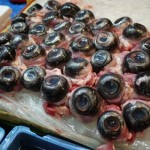
A recent study by Gallucci et al. manages to pull this off. Classic caging experiments (where a cage is used to cover an area to prevent the big guys from chomping away on the wee’ guys or plowing around the sediment generally making a mess of things) were conducted at the HAUSGARTEN site. Apparently, Hausgarten is German for we have lots of money to conduct really cool seafloor experiments so suck on this. Six experimental cages were deployed at 2500m depth (~1.5 miles) and sampled after 4 years. The absence of the big guys, i.e. megafauna, actually lead to less variability in the sediment characteristics. Nematodes, which you should care about because they secretly rule the world, were more abundant inside the cages. This increase in abundance mainly came from rarer (typically low abundance nematodes) increasing in numbers. Interestingly, diversity of nematodes and the taxonomic distinctness of nematodes was greater outside the cages. So what does this all mean?
megafaunal organisms play an important role in creating microhabitats in the sediment and significantly influence deep-sea nematode assemblages
GALLUCCI, F., FONSECA, G., SOLTWEDEL, T. (2008). Effects of megafauna exclusion on nematode assemblages at a deep-sea site. Deep Sea Research Part I: Oceanographic Research Papers, 55(3), 332-349. DOI: 10.1016/j.dsr.2007.12.001






Yep! The deep sea is a wondrous place for sure! It is a shame there isn’t the funding to push for habitation there like for space. I am sure there are lots of mysteries down there that could be just as much benefit to mankind as the riddles were unfolded!
Dave Briggs :~)
Cool. Deep down top-down effects!
If I find a spare 400K lying around I’ll send it your way, as long as long as I can tag along.